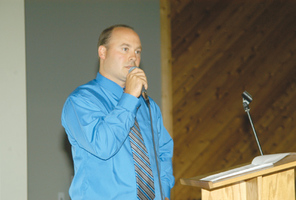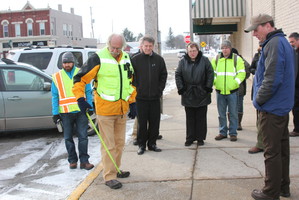News
Check back here regularly to find out what's going on at Justin Wing Engineering.
Officials: Access Management could improve local traffic flow
Officials: Access management could improve local traffic flow
July 14, 2010|By Ryan Bentley News-Review Staff Writer
By limiting potential conflicts in motorists’ movements, transportation officials believe there are opportunities to improve safety and traffic flow on Petoskey-area highways.
Representatives from the Michigan Department of Transportation and Northwest Michigan Council of Governments reviewed this concept — known as access management — with local officials and residents during two meetings Tuesday at the Emmet County Fairgrounds Community Center.
The council of governments is cooperating with several area governments — including Emmet County and its road commission, the city of Petoskey, Bear Creek Township and the Little Traverse Bay Bands of Odawa Indians — to develop a plan for how access management techniques could be used locally.
“It is relevant as our region continues to grow and expand,” said Matt McCauley, regional planning director for the council of governments.
The Petoskey Area-wide Transportation Study — which set out to find alternate ways to improve the area’s traffic flow following the state’s 2002 decision against building a U.S. 31 bypass — encouraged an access management plan to be pursued locally.
Adding turn lanes to roadways, elimination of driveways near busy intersections and consolidation of driveways are a few examples of access management techniques.
Before setting out to identify specific spots where this could be used, council of governments regional planning director Matt McCauley said the governments scheduled Tuesday’s meeting to explain the concept and provide the public with an opportunity for some initial suggestions.
Justin Wing, an MDOT planning and utilities engineer, noted that some access management techniques were incorporated when U.S. 31 was upgraded between M-119 and Conway during the past several years.
“When you drive through there now, it’s a lot less confusing,” he said, adding that average traffic speed measurements in the area have shown an increase from 51 to 53 mph.
MDOT also sees opportunities to put access management techniques to use as it upgrades and resurfaces some other local segments of U.S. 31 in the next few years.
MDOT representative Tom Doyle noted that local governments also can play a part by requiring site plans for construction projects to use access-management techniques for roadway access.
After local officials identify possible uses for access-management techniques over the next couple of months to use in a possible plan, McCauley said the public will have another opportunity for input on these during a mid-September meeting.
Local governments could consider making access management part of their planning and zoning rules through their own policymaking processes later, he added.
More visible traffic signals along the U.S. 31 North corridor, extension of a left turn lane along M-119 near the Petoskey State Park and the use of roundabouts at busy intersections were among the suggestions the public offered during Tuesday’s first session for improving on traffic flow and road safety.
Ryan Bentley
439-9342 - rbentley@petoskeynews.com
Walkability audit kicks off plan to reconstruct downtown
Posted by Eric Young
Managing Editor | editor@ogemawherald.com
989-387-9036
WEST BRANCH — It might be hard to imagine a roundabout on Houghton Avenue, but that was just one of many ideas discussed Feb. 26 to help improve the walkability of West Branch.
Dan Burden, executive director and co-founder of the Walkable and Livable Communities Institute, met with community and business leaders to present examples of other communities that have made changes to their downtown areas to make them more walkable and bring more people into town. He also performed a walking audit of the downtown area, where he made some suggestions on things that could be changed to help the area.
One of those was a roundabout to replace the traffic light at Houghton Avenue and Third Street. Burden suggested it would improve the flow of traffic, as well as make it easier for pedestrians to cross. When asked if he thought it would really work in West Branch, he said it could.
“It’s a powerful idea,” he said. “Maybe (it would work). I don’t look at it as a tool just to move traffic better. But it would be a focal point. I think it would fit if you eliminated left-hand turns for trucks.”
Burden also suggested reducing the number of lanes downtown from four to two, which would allow for a buffer lane that could double as a bike lane, as well as angle-out parking, which would create many more parking spots along Houghton Avenue.
“I’m a strong proponent of back-in angle parking, or head-out over head-in,” Burden said. “It’s safer. It’s intuitive. It puts the trunk where you want it to be. When you pull out, you have a total view of the street.”
However, Burden suggested changing the parking somewhere else before making the switch on Houghton.
“Don’t put it on Houghton first,” he said. “Put it on a couple side streets. Get people used to the idea and get them to come to you and say they want it on Houghton.”
In addition, angled parking currently is not allowed on a state highway, which Houghton Avenue is. So legislation would have to be passed to allow it.
But there is plenty of time for that. Burden’s visit was just the beginning of what is expected to be a long process of planning a reconstruction of the downtown area. Last summer, the Michigan Department of Transportation reconstructed both ends of the Business Loop, from the city limits to Exit 212 and 215, leaving the downtown area as the only place that hasn’t been done.
And while the planning is entering its infant stages for the reconstruction, MDOT officials said it could be some time before the project is actually completed.
“Unless we get this road funding (Gov.) Snyder is trying to push though, the earliest we’re looking to do Houghton is 2019,” said Justin Wing, traffic and safety engineer for MDOT’s Gaylord Transportation Service Center.
But City Manager Tom Youatt said with the proper planning, there is a chance the project could be completed sooner.
“I believe that it’s possible to move that up, depending on your ability to get grant funding,” Youatt said. “MDOT has worked very well with communities in the past.”
Youatt added that the city would not be rushing into the project either.
“There’s a lot of issues that need to be addressed,” he said. “We want to keep the momentum moving forward with this project. It’s a project that really needs to be done sooner rather than later. Especially since MDOT invested in rebuilding the Business Loop. We want to do everything we can to move this project forward and continue with the planning process to the point that we have some consensus from the community and what we want the downtown to look like, put together a plan and getting to outline a budget.”
Youatt said he expects the city and the Downtown Development Authority to keep an open mind throughout the project.
“In my mind, anything is possible,” he said. “We would have to work with MDOT very closely on this, and the city engineer — put a little more research into it. The ideas that (Burden) presented fit in with what we’re trying to do downtown very well, with the number of events we have downtown. And the type of events we’re putting on downtown fit in very well with many of (Burden’s) ideas about making it more walkable and pedestrian-friendly, a place where people want to go.”
The idea of reducing the number of lanes downtown is what Burden calls a “road diet.” He said two lanes would easily support the traffic that comes through downtown, and it would make crossing the street easier and faster for pedestrians because they wouldn’t have to travel as far from one side to the other. He said two lanes of traffic can support 36,000 cars a day, less than the estimated traffic that currently goes through West Branch.
“I think you’ve got a lot you can do with these dimensions,” Burden said about the space downtown. “You’re fortunate to have this much space.”
“You have more space than is needed for what you’re doing,” he added. “You can put it to better use.”
And Wing said MDOT has become more open to Burden’s ideas.
“Depending on things like the signals and intersections, I think MDOT is getting more open-minded every day about road diets,” Wing said. “We’re trying them in different spots.”
And some changes will be coming this year, unrelated to the future project. Wing said plans are to replace the current traffic light at Houghton Avenue and Third Street — it’s one of the oldest signals left. He said buttons will also be put in at the pedestrian crossing, which will shorten the wait times at the light when people are not crossing the street.
Youatt said he plans to continue the process of planning for the future. Burden’s presentation was recently shown to the DDA, and will be shown to the city council and the planning commission as well. He said he is also seeking feedback from the public.
“We want as much input from our citizens about what kind of downtown they want to see,” Youatt said. “And working with MDOT — they’re critical. We learned some things. I thought overall it was a very worthwhile experience, and we learned a lot that will help us with our planning efforts in the future.”
“Although we’d like to see this done sooner, this project will take time,” Youatt added. “If we’re going to do a successful reconstruction of the downtown, we need to make sure to put a lot of thought and planning into it. You only do a project like this every 40 or 50 years. So it is important to do it right.”




